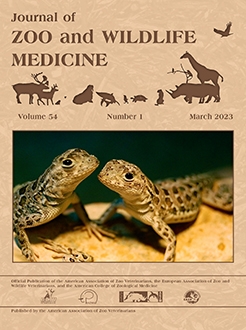Large blooms of the dinoflagellate Karenia brevis cause annual harmful algal bloom events, or “red tides” on Florida's Gulf Coast. Each year, the Clinic for the Rehabilitation of Wildlife (CROW) is presented with hundreds of cases of aquatic birds that exhibit neurologic clinical signs due to brevetoxicosis. Double-crested cormorants (Phalacrocorax auratus) are the most common species seen, and typically present with a combination of ataxia, head tremors, knuckling, and/or lagophthalmos. Blood lactate levels are known to increase in mammals for a variety of reasons, including stress, hypoxia, sepsis, and trauma, but there is limited literature on blood lactate values in avian species. The objective of this study was to determine the prognostic value of blood lactate concentration on successful rehabilitation and release of birds presenting with clinical signs consistent with brevetoxicosis. Blood lactate levels were collected on intake, the morning after presentation and initial therapy, and prior to disposition (release or euthanasia) from 194 birds (including 98 cormorants) representing 17 species during the 2020–2021 red tide season. Overall, mean blood lactate at intake, the morning after intake, and predisposition was 2.9, 2.8, and 3.2 mmol/L, respectively, for released birds across all species (2.9, 2.9, and 3.2 mmol/L for released cormorants); 3.4, 3.4, and 6.5 mmol/L for birds that died (4.0, 3.5, and 7.9 mmol/L for cormorants that died); and 3.1, 3.5, and 4.7 mmol/L for birds that were euthanized (3.5, 4.7, and 4.9 mmol/L for cormorants that were euthanized). On average, birds that died or were euthanized had an elevated lactate at all time points as compared to those that were released, but these results were not statistically significant (P = 0.13). These results indicate that blood lactate levels do not appear to be useful as a prognostic indicator for successful release of birds, including double-crested cormorants, affected by brevetoxicosis.
How to translate text using browser tools
20 March 2023
INVESTIGATING BLOOD LACTATE CONCENTRATION AS A PROGNOSTIC INDICATOR FOR BIRDS PRESENTING WITH BREVETOXICOSIS: 2020–2021
Alexandra T. Troiano,
Melanie Peel,
Angus I. Cameron,
Robin Bast,
Leanne Flewelling,
Jay Abbott,
Heather Barron
ACCESS THE FULL ARTICLE





